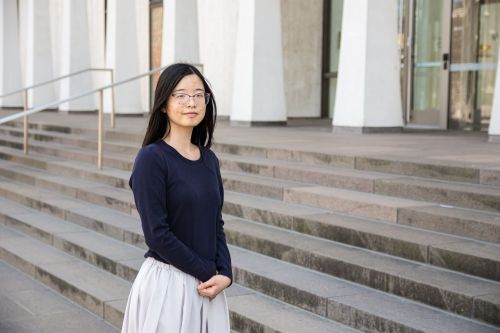
Being a researcher takes a bit of detective work. When Katie Wu is in the lab, she is often reminded of the famous saying from Sherlock Holmes: “when you have eliminated the impossible, whatever remains, however improbable, must be the truth.”
“In scientific research, things often do not go as planned, but that makes it even more exciting. You have to be a detective, look for clues, design experiments, come up with other possible causes, and rule things out,” describes Katie, who is a first-year graduate student in Mechanical & Aerospace Engineering at Princeton.
For Katie, there is no greater thrill than cracking a good scientific case. She began her journey as a researcher in the Fluid Dynamics Research Lab at Brown University. She immediately became enthralled with the field through investigating bio-inspired and unsteady flows. Eager to learn more, she spent a year in Japan as part of the Fulbright Program furthering her knowledge of bio-inspired locomotion studying the dynamics of swimming underwater snake robots. Today, she is conducting experimental fluid mechanics research at Princeton in Professor Marcus Hultmark’s FAST (Fundamentals and Applied Studies in Turbulence) laboratory.
“Fluid mechanics is everywhere, and it is essential for the study of so many other fields, including environmental science and biology,” explains Katie. “As I investigated questions at the intersection of fluid dynamics and biomechanics, I was deeply impressed by the ingenuity of the methods which researchers have developed to measure, understand, and manipulate the physical world. The field is exciting because there is so much to explore and every day in the lab is different.”
As one of the newest members of the FAST Lab, Katie started a project to study hydraulic transients and develop a viscosity sensor using a novel flow sensor designed by the lab. However, the project did not turn out to be as straightforward as they had originally anticipated.
“At first, Professor Hultmark and I thought the viscosity sensor project would be simple. However, it turns out the prevailing theory, which is widely used to describe the start-up behavior of fluid in a pipe, is not relevant for all cases. We observed behavior that we did not expect to see, and now we are trying to figure out what is causing it,” she says.
To explain her project, Katie says to imagine what happens when you first open a valve and fluid starts flushing out. There are some temporary behaviors that occur before the stream becomes steady. These behaviors are determined by the viscosity and the density of the fluid among other things.
Katie is using the nanoscale flow sensors developed by Professor Hultmark and his lab to measure this behavior and to develop a way of obtaining the fluid viscosity. “It is very exciting because the idea has not been explored extensively before,” she says. “Being able to measure the viscosity of fluids is important for many industrial applications, including quality control for food products and cosmetics, as well as for predictive maintenance of machinery. There are also important applications in medicine—analyzing the viscosity of blood could allow for more personalized healthcare and improve the quality of the patient experience.”
In the past, measuring viscosity has been a lengthy process that requires expensive, high-tech equipment. Samples are typically sent to specialized laboratories for analysis. Sensors that provide immediate viscosity measurements could improve and expedite the process dramatically.
Katie first became interested in mechanical engineering because she wanted to understand the technology that shapes life. “Solutions to the many of the problems the world is facing today involve mechanical engineering. The math and analytical skills you learn in the major can be useful for any number of things,” she explains.
Even though she was an engineer at heart, Katie was drawn to Brown University as an undergraduate for its liberal arts focus. Always looking for a larger perspective, some of her favorite courses were in humanities. She particularly enjoyed a class that was cross-listed between the history and environmental science departments which focused on the history of human energy consumption.
Bio-inspired Dynamics Research
During her time as an undergraduate, Katie’s research in bio-inspired, robotic flapping wings involved biology, robotics, and engineering. She was granted a university fellowship to conduct experimental investigation of aerodynamic force generation by passive-pitching flapping wings.
“A robotic wing is a research tool that complements measurements taken of live animal flight,” explains Katie. “A robotic test apparatus offers particular benefits: high repeatability, freedom to change dynamic scale, and the ability to investigate wing kinematics not observed in nature. Such understanding also guides the engineering design of bio-inspired flying vehicles.”
Katie’s work was published in the Journal of The Royal Society Interface, received the Brown University Distinguished Senior Thesis Award, and was presented at the 2019 American Physical Society Division of Fluid Dynamics Meeting.
Even though Katie is just at the beginning of her journey as a Princetonian, she hopes to never leave academics. Her goal is to become a university professor one day. “A career in academia is an unparalleled opportunity for continued learning and intellectual challenge,” she says. “I am excited to solve problems of global importance and prepare students to address the pressing needs of the future.”
-- Carolyn Sayre